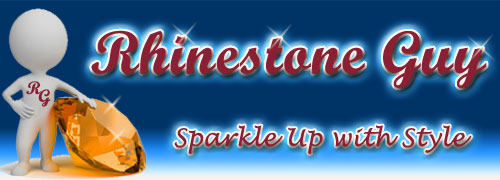Rhinestones Ideas in Leather
How to make Belts, Dog Collars with rhinestones
We get at least 10 calls per day about "How do I make a "Kippy" Belt (no pun intended), a dog collar, a leash, etc...all having to do with leather. I also hear from the Rodeo set about decorating shirts, vests, and coats. Here is the info.
PLEASE NOTE: Heat Fix rhinestones and Leather do not mix!
Belts:
There is NO machine that can put standard rims sets or tiffany mounts through belt-weight leather...it is not the machine, it is the Rim Sets or tiffany mounts that fail in the process. These items cannot withstand the toughness of heavy leather and the their prongs will bend and flatten long before they penetrate heavy leather! So please don't think you can run out, buy a belt, then decorate it.
Don't promise a dog collar that you cannot produce simply by applying rhinestones to it! But, there are ways of making a great belt or collar,
and here is how it is done:
Get yourself a piece of shirt-weight lambskin or cowhide that is long enough to make a belt, collar, or whatever you are doing. This stuff can be cut into lengths, is light-weight, and easily worked. Line the light-weight leather up to the belt, mark the width and leave about 1/4" extra on each side. (leave as much as you want for waste, but know where the belt will be with respect to the light-weight leather. Plan your design using rhinestones with rim sets, nailheads if you like. Usually, belts look best if designs include different sizes of rhinestones. Keep your designs off the finished edge about 1/4", as any closer will interfere with final bonding to belt back.
Once the design is finished, get yourself some shoe sole glue (shoe repair shops) and follow recommendations as to bonding the leather to the leather. Trim the bonded, decorated leather at an angle using an X-Acto knife with a NEW blade ...never use a dull blade! If you wish to rhinestone-cover the buckle, use either 9SS or 12SS rhinestones, glue with E 6000, GemTac, or Epoxy glue. Be careful when handling Epoxy glues...very allergenic.
To make the belt, use appropriate rim sets and rhinestones, stick to round nailheads. Rims can be long leg if necessary, depending upon thickness of light-weight leather.
Trade secrets: The most popular belt brand this year is using a specific rim for 40SS rhinestones. This guy looks like it has a rope edge, is available in silver or Gold only at this time...see rim sets (Mountings).
Collars:
Read the above concerning belts...no difference except for width.
Edge Stitching:
Fine belts and collars are edge stitched to bond the layers. If your sewing machine cannot penetrate the layers, consider taking to a shoe shop. But! you must allow a given area of leather free of decor to pass through the feed dogs of the sewing machine. This will limit the decoration, and it really isn't necessary.
If you are sewing leather, use only a LEATHER needle. These needles have a knife edge to cut through the leather when the machine passes the needle into the material. DO NOT sew fabric with a leather needle, as the needle will cut the fabric fibers and cause fraying.
Shirt Designs, Insets:
Show clothing for the horse circles is another animal all together. Rim Sets and Tiffany mounts can usually be used straight up, but in areas of multiple fabric thickness, long leg settings are a must. Remember, when you use rim sets, the folded prongs with be on the inside of the clothing. A possibility of snagging underlying garments exist. Therefore, line areas that are rim set wherever possible. IF you cannot line the areas that are rim set, consider placing glue over the points of the setting prongs. Here, GemTac is easy to use, but in times of dampness (sweating), it can become somewhat tacky to the touch.
Tiffany mounts present the opposite problem in that they can snag garments on the Top side. IF you are wearing slinky knits under a vest, be careful when handling a garment with tiffany mounted rhinestones.
Warning about the use of any glue: To my knowledge (limited at best, but probably better than yours), acrylic glues are just wonderful for most things. These glues adhere to just about anything ...paint, glass, metal, fabric, leather (to some extent), suede, Ultra suede, vinyl, you name it ....BUT ...these glues fail miserably when the temperature of what they are bonded to falls below freezing. The glue becomes very brittle and the stones will just pop off all over the place. In southern climates, no problem. But if you are gluing to coats, especially leather coats whose temperatures will fall below freezing when worn, glue is NOT the answer. Do not use glue for automobiles, motorcycles, ...anything that will be outside in temperature below freezing. Stay tuned for more glue advice as it comes in. We are searching for a suitable glue for below freezing temperatures that is easy to use and will bond rhinestones. If you have any knowledge of these glues, PLEASE call me.
DO NOT USE EPOXY GLUES. these glues cause terrible allergic reactions over time. No matter who you are, given enough time, you will develop an allergy to these glues. The allergic response can be quite remarkable. I have seen people with running sores all over their hands and arms from the use of this stuff. The allergic response can come on quite suddenly, even to those who have never been allergic to Epoxies before. Epoxy glues almost always discolor to an amber color, they are very brittle, and they are mess to use. If you use this stuff after this warning, do NOT use acetone or benzene to clean it off your skin. These chemicals go right through the skin and can cause serious damage to your kidneys without your knowing it. Benzene is a very strong carcinogenic liquid, causing Leukaemia and other nasty cancers. There is no reason in the world to have benzene in your house, period. If you use epoxy glues, clean off any that gets on your skin with alcohol as soon as possible. Clean well, then use a lot of soap and water. If you are still sticky, repeat this process. I am not in the habit of writing warnings without strong knowledge of what I am writing about. You have been warned.
Tools for use in mounting to leather:
For the average person doing an occasional belt or collar, the Hand Press or Foot Press with appropriate dies is what you will need. You will be working "upside down" with any press on the market, unless you choose to upgrade a foot press to vacuum operation (very expensive option). Mark all design patterns on back of material and punch away.
IF you are going into a Cottage industry, consider the Foot Press with appropriate dies. Your life will be a lot easier if you use this tool. Seriously consider a vacuum attachment for the machine, as with this device, you can work right side up. Vacuum attachments are expensive, usually driving the price of the foot press up about $350 to $400 , but it is a real time saver and accuracy improves greatly when you work right side up.
Don't even think about using a BeDazzler for leather --tool...will fail immediately, and leather is expensive, so do it right. You CAN use the Simple Setter and punch through the leather by hand, then use the Simple Setter to bend over the prongs.
Don't even think about heat setting rhinestones to leather! Glue will hold rhinestones to leather in areas where no abrasion is encountered, such as shirt fronts or yokes of shirts. BUT, do not attempt to glue rhinestones to belts or animal collars...loss of stones will occur immediately, and, with animal collars, the animals my eat these stones, crushing them with their teeth, and consume BROKEN GLASS! That is a sure way of endangering an animal's life!
DO NOT consider tiffany mounts for either Belts or Animal collars. The prongs can open with strong abrasion, the stone will be lost, and nasty sharp prongs will be exposed. This can ruin furniture, and absolutely will cut an animals paws if it scratches and hits an open tiffany prong!!!!!!!!
You can use Gem Tac glue with leather, it holds ok, but does not penetrate the leather. You may loose a few stones every once in a while, but by and large, the glue holds them well. BUT NOT with belts and collars!
Acrylic rhinestones may not be the best choice for dog collars...they can scratch them with their nails when the go to the 'itchy-scratchy thing.
We carry a line of Rim Sets made for heavier leather. They have 2 legs and are available for sizes 20SS, 40SS, and 48SS. Call for prices after December 20, 2004.
Rhinestone Size Considerations:
The smallest rhinestone I will rim set is a 20SS (about 5mm). 16SS and smaller rhinestones have far too much rim and not enough rhinestone showing after the setting is complete. You will be just as happy with a nail head if you want smaller decorations. A 30SS or larger rhinestone looks great in a rim set.
Do NOT use Tiffany mounts on a Belt or Collar. The prongs will snag and bend, allowing the stone to fall out. Generally, the larger the rim set, the longer the mounting prongs are. But, you may want long leg rim sets for leather work.
Alternatives:
When decorating belts, if you choose NOT to laminate layers of leather, you can opt for rhinestone Rims made for heavy leather. We stock a 48SS silver rim sets designed for belts. It has 2 legs designed to curl under when mounting to the belt with the proper die. You will need at least a commercial hand press with proper dies to use this item. The rim set will hold an 11 mm jewel or a 48SS rhinestone. We also have nailheads built the same way, but you will need the special tools/dies/press to use them. I suppose you could pre punch a 2 holes in leather and curl the legs using needle nose pliers, but that is up to you and your experimentation.




